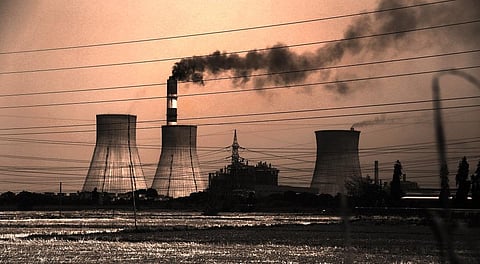Budget 2023-24: Centre lacks clarity on India’s climate change obligations
India is moving forward firmly for the ‘panchamrit’ and net-zero carbon emission by 2070 to usher in a green industrial and economic transition, Union Finance Minister Nirmala Sitharaman said in her budget speech.
“This budget builds on our focus on green growth,” she added. The budget has also allocated Rs 35,000 crore for priority capital investments towards energy transition and net-zero objectives.
In 2020, another statement made by the minister while presenting the 2020 budget said: “Power utilities running old thermal power units would be asked to shut them if these emitted more than the ‘pre-set norms’.”
Contrary to these statements, the government has asked power utilities not to retire any coal-fired thermal power units till 2030, according to a recent Central Electricity Authority (CEA) notice (dated January 20, 2023) accessed by Reuters.
The notice, sourced through an official at CEA on the conditions of anonymity, directed these utilities to ensure the availability of thermal power units after completing renovation and modernisation.
This comes after a meeting between officials from the Ministry of Power (MoP), National Thermal Power Corporation (NTPC) and CEA on December 12, 2022.
Power minister RK Singh, during the meeting, instructed thermal power plants not to further retire units until 2030 but rather to take measures to ensure the extension of the lives of plants that are slated for retirement.
The minister stated that the move is under the purview of “an expected increase in demand scenario.”
A 2021 notification by the Ministry of Environment, Forest and Climate Change (MoEFCC) provided a structure for categorising coal-based thermal power plants and implementing the norms.
The deadlines for 78 per cent of the coal-based thermal power capacity to meet the emission norms were extended by another two-three years (i.e. to 2024), according to this notification. This is the third relaxation of deadlines by the government.
Thermal power units of more than 4.6 gigawatts (GW) are scheduled to retire between 2022 and 2027, according to National Electricity Plan (NEP) 2022.
All these events indicate the government’s lack of clarity on how it intends to meet climate change obligations.
Now there are many questions which need to be answered regarding the latest CEA notice: Why is the government changing its stand on the retirement plan of the units? Is there any solid plan to ensure the compliance of these ageing units, which are supposed to retire (aged over 25 years) by 2030? How much increase is expected in the demand scenario and can it not be met by new power plants based on efficient and cleaner technologies? What impact will it have on the greenhouse gas emission scenario of the sector, which is already about 50 per cent of the sector-wise carbon dioxide (CO2) emissions?
The retirement of old and inefficient units of thermal-power stations and their replacement with new and more efficient units is one of the major initiatives required to improve the average efficiency of the fleet and reduce its CO2 emissions footprints, according to a 2020 report by Delhi-based non-profit Centre for Science and Environment (CSE).
Currently, the power sector, with a total capacity of 203 GW, has a total coal requirement of 2.77 million tonnes of coal on a daily basis. This, in turn, emits about 3-9 million tonnes of CO2 daily, depending on the type of coal used (bituminous, sub-bituminous or lignite).
About 32 GW of thermal capacity will likely be included in national capacity by 2024-25, according to the CEA report on under-construction thermal power projects.
Introducing new and efficient coal units will reduce CO2 emissions by 2-3 per cent, with every rise in efficiency by about 1 per cent.
CEA notified its Flexible Operation of the Thermal Power Plants on January 25, 2023. The objective is shifting to “efficient flexible operation with lower emissions,” the notification stated.
The ‘to-be retired’ and other inefficient and polluting units, if they need to operate till 2030, need to comply with this regulation at the earliest, along with an emphasis on meeting environmental compliance, it added.
There seem to be no grounds for why the old units, which are supposed to retire in the next couple of years, should continue to operate inefficiently and pollute the environment.
The government should not allow the ageing units to operate endlessly and instead consider the environmental damage and GHG emissions from such units.
The increase in expected demand can be easily met with alternate options of either new fleets or efficient, flexible operations with lower emissions.
There is an urgent requirement for the government to review its strategy related to the power sector and ensure that it should be in line with the country’s net-zero emission obligations and green energy transition initiatives.
The CEA notice on extending the retirement of coal-powered thermal power plants will only prove to be a licence for inefficient power generation units to pollute the environment.
Inefficient power-generating units lead to higher GHG emissions. SO2 (sulphur dioxide) emissions control systems are still not installed in many units, said Nivit Kumar Yadav, programme director of the Industrial Pollution Unit, CSE.
“It is to be noted that it takes about two to three years to install SO2 control equipment. When we are talking about the extension of the life of units by seven years, does it mean that these units will continue to pollute the environment on the grounds of the CEA notice?” Yadav asked.
This certainly points to a difference between the words and actions of the government. It seems that the authorities lack clarity about the climate change ambitions of the country. The government should come up with a clear strategy for the ‘decarbonisation of the power sector and develop a clear plan for phasing out inefficient and polluting units, he said.
The thermal power sector also has to take the lead if we as a country have to comply with climate change obligations, he added.


